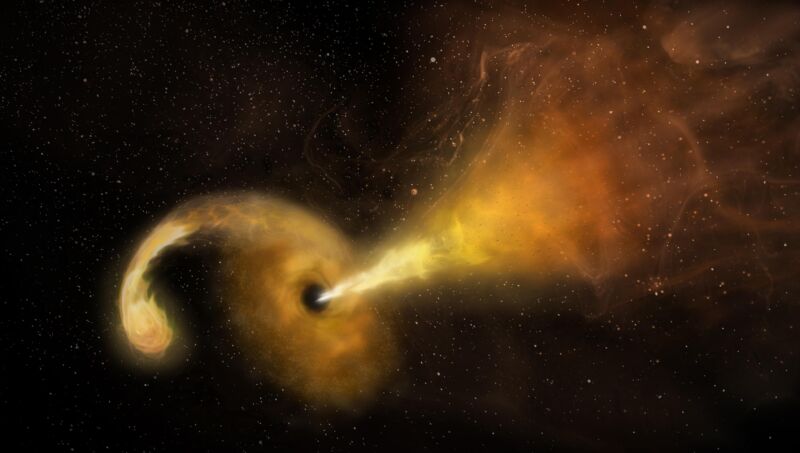Virtually anything in space could be a potential meal for a supermassive black hole, and that includes entire stars. Even stars much bigger than our Sun can fall victim to the black hole’s extreme gravity and be pulled in toward its gaping maw. It is a terrifying phenomenon, but how often does it really happen?
Tidal disruption events (TDEs)—when the tidal forces of a black hole overwhelm a star’s gravity and tear it apart—are thought to occur once every 10,000 to 100,000 years in any given galaxy. TDEs can be detected by the immense amounts of energy they give off. While observations of them are still pretty rare, an international team of researchers has now discovered a whopping 18 of them that previous searches had missed. Why?
Many TDEs can be found in dusty galaxies. Dust obscures many wavelengths of radiation, from optical to X-rays, but long infrared wavelengths are much less susceptible to scattering and absorption. When the team checked galaxies in the infrared, they found 18 TDEs that had eluded astronomers before.
Hidden in plain sight
Until now, most tidal disruption events were detected in the optical and X-ray bands. Searches for TDEs that gave off optical emissions (meaning visible light) and X-rays led to an increase in TDE discoveries in the 2010s. These methods can still detect some TDEs—but not all of them. The problem is that both of these types of radiation have short wavelengths that can be easily scattered and absorbed by dust, which will obscure objects and phenomena inside any dust-rich galaxies.
The supermassive black hole in a galactic core is what causes TDEs. The dust and gas in a black hole’s accretion disk don’t help with detection.
Most of the TDEs discovered by the research team had not previously been detected in the optical band by the WISE or NEOWISE infrared observatory mission. When they looked for these events in data from NASA’s WISE (Wide-Field Infrared Survey Explorer) and NEOWISE missions, along with data from other missions such as SRG’s eROSITA all-sky survey, the optical and X-ray bands did not show much. It was only when the researchers looked at WISE/NEOWISE mid-infrared data that they discovered hidden TDEs.
In a different light
Tidal disruption events that can only be observed in the infrared have huge implications for the actual TDE population out there, which was hard to estimate based on those that had only been detected in the optical and X-ray bands. It also solves the mystery of why there appeared to be a lack of TDEs in star-forming galaxies, which tend to be rich in dust.
Included in the 18 newly discovered events is what is now the closest known TDE to Earth. It resides in an especially dusty star-forming galaxy, which would have made it almost impossible to see without infrared observations.
Star formation has had an impact on where astronomers looked for TDEs. Until now, galaxies that no longer formed stars were seen as ideal places to search for TDEs because they were low in dust. As stars are born in massive clouds of dust and gas, it appeared as if there were no TDEs in star-forming galaxies when they were observed in shorter wavelengths. This explains why TDEs were thought to most likely occur in galaxies where star formation has ceased or nearly ceased.
Dust may get in the way most of the time, but it has one advantage that actually helped the researchers find some previously unknown TDEs. An enormous amount of heat is produced as stars are dismembered by supermassive black holes. Dust echoes occur when dust particles are heated up and emit radiation, generally infrared radiation. These dust echoes can also help with detecting hidden TDEs.
The infrared detection of so many TDEs also potentially answers the “missing energy” question. TDEs are theoretically predicted to put out more energy than we have observed, so where did the rest of it go? The researchers who found the new TDEs suggest that the impression of missing energy came from our inability to observe radiation being obscured by dust and gas—no energy was missing; it had just gone undetected.
It turns out that TDEs may not be as rare as we thought. They may also get even less elusive before too long. Astronomers will have a much clearer idea of the population after future surveys, such as the Legacy Survey of Space and Time (LSST) at the Vera Rubin Observatory, which searches for them with infrared vision. Surveys this powerful may be able to find hundreds, even thousands, of TDEs every year.
“This work represents the cleanest sample of [infrared]-selected TDEs to date,” the research team said in a study recently published in The Astrophysical Journal. “As such, it presents new insights into TDE demographics in the local Universe and allows us to probe the properties of a previously overlooked class of TDEs.”
The Astrophysical Journal, 2024. DOI: 10.3847/1538-4357/ad18bb
